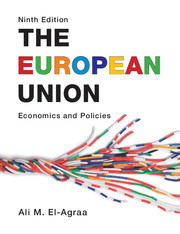Book contents
- Frontmatter
- Contents
- Figures
- Tables
- Boxes
- Contributors
- Preface
- A reader’s guide
- Abbreviations
- 1 General introduction
- Part I EU history, institutions and legal dimension
- Part II EU market integration
- Part III EU monetary integration
- Part IV The single European market
- 13 Competition policy
- 14 Industrial and competitiveness policy
- 15 Tax harmonization
- 16 Transport policy
- 17 Energy policy and energy markets
- 18 Environmental policy
- Part V EU budget and structural policies
- Part VI EU external relations
- Part VII The future of the EU
- Bibliography
- Author Index
- Index
- References
17 - Energy policy and energy markets
from Part IV - The single European market
- Frontmatter
- Contents
- Figures
- Tables
- Boxes
- Contributors
- Preface
- A reader’s guide
- Abbreviations
- 1 General introduction
- Part I EU history, institutions and legal dimension
- Part II EU market integration
- Part III EU monetary integration
- Part IV The single European market
- 13 Competition policy
- 14 Industrial and competitiveness policy
- 15 Tax harmonization
- 16 Transport policy
- 17 Energy policy and energy markets
- 18 Environmental policy
- Part V EU budget and structural policies
- Part VI EU external relations
- Part VII The future of the EU
- Bibliography
- Author Index
- Index
- References
Summary
Introduction
Energy has been central to the European Union (EU) ever since its inception: witness the creation of the European Coal and Steel Community (ECSC) in 1951, and the European Atomic Energy Community (Euratom) in 1957. The details of these treaties (and their rationales) are covered in Chapter 2, but their significance for energy policy is clear enough. The ECSC reflected the dominance of coal in the energy balance of member states (as well as its role in the steel industry): by tackling coal, most European Community (EC) energy supply and demand issues were addressed. Euratom sought to foster cooperation in the development of civil nuclear power, then perceived as the main source of future energy requirements (Lucas 1977). Moreover, in principle, both were geared towards the creation of free and integrated markets in these sectors: the ECSC, being a common market (CM; see Chapter 1), sought to abolish all barriers to trade between the Member States (MSs), while controlling subsidies and cartel-like behaviour among producers, and Euratom aspired to do likewise for nuclear products.
A CM for other energy sectors was addressed in the EEC Treaty. While the EEC was oriented towards more or less competitively structured sectors, it also applied to the more oligopolistic or monopolistic sectors, such as oil, gas and electricity. Accordingly, in addition to being subject to the EEC Treaty’s general provisions on opening up markets, these energy industries’ special characteristics were covered by the Treaty’s provisions on state enterprises and their conduct (see Chapter 13).
- Type
- Chapter
- Information
- The European UnionEconomics and Policies, pp. 257 - 269Publisher: Cambridge University PressPrint publication year: 2011
References
- 1
- Cited by



